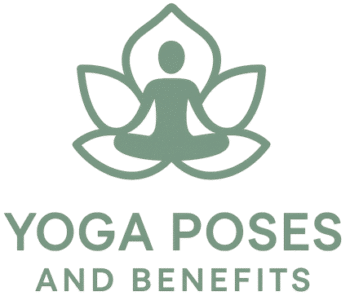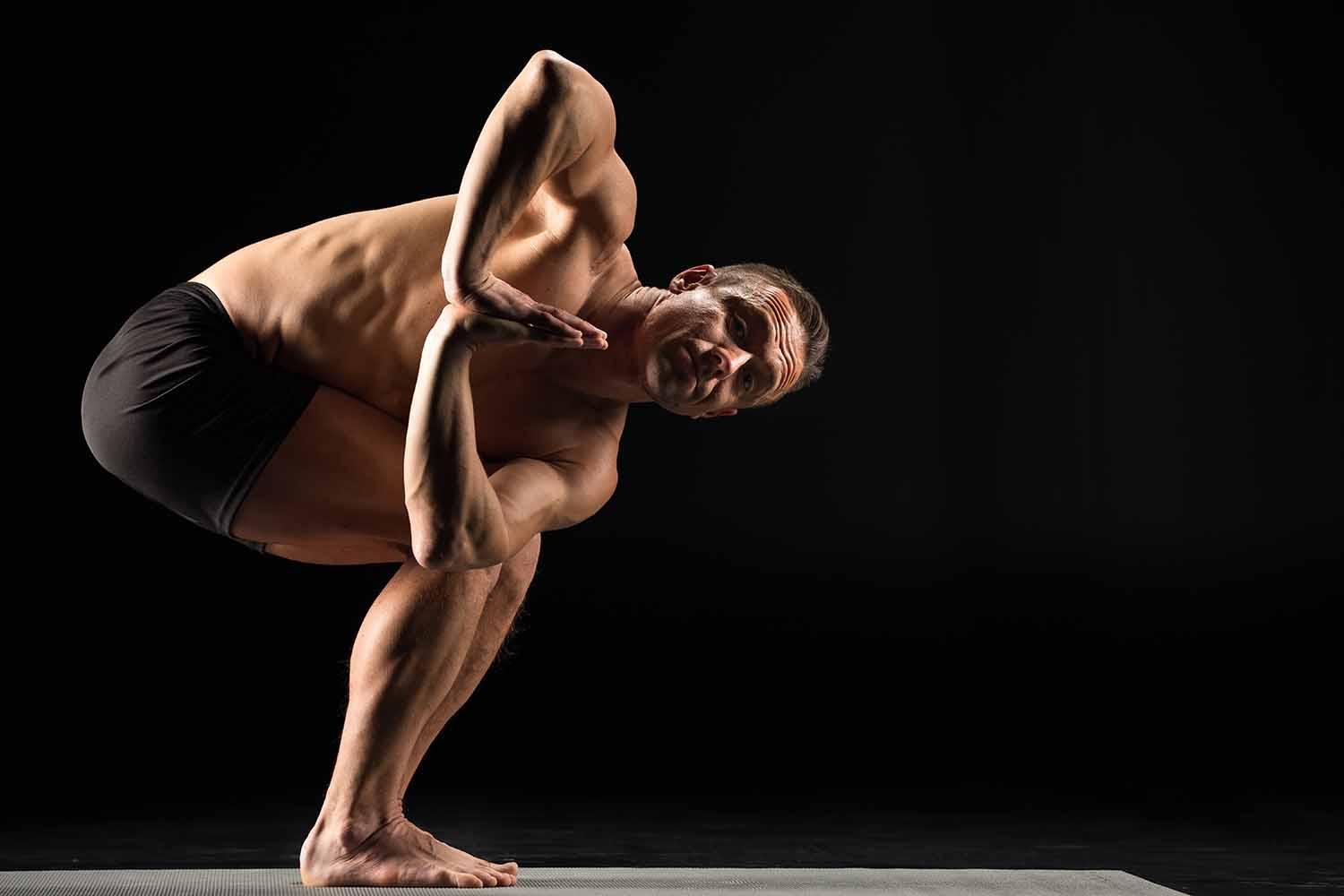Revolved Chair Pose in yoga (Parivrtta Utkatasana) is a powerful twisting posture that strengthens the legs, glutes, and core while opening the chest and improving spinal flexibility. The twist promotes detoxification and stimulates digestion, making it a great addition to yoga flows. It challenges balance and stability, requiring focused breathwork and engagement of multiple muscle groups.
Other Names for Revolved Chair Pose
- Parivrtta Utkatasana
- Twisting Chair Pose
- Revolved Fierce Pose
How to Do Revolved Chair Pose in Yoga
To perform Revolved Chair Pose, follow these detailed steps:
- Start in Mountain Pose (Tadasana) with your feet together and arms at your sides.
- Bend your knees and sink your hips back, as if sitting in a chair, keeping your thighs parallel to the floor.
- Bring your palms together in prayer position at your chest.
- Inhale deeply, and on your exhale, twist your torso to the right, bringing your left elbow to the outside of your right thigh.
- Keep your hips square and your knees even, avoiding twisting through the lower body.
- Press your palms together firmly, using the leverage of your elbow against your thigh to deepen the twist.
- Lengthen through your spine on every inhale and twist deeper on every exhale.
- Hold for several breaths, then return to Chair Pose and repeat on the other side.
Variations of Revolved Chair Pose
Exploring variations of Revolved Chair Pose can deepen your practice and offer new challenges:
- Open-Armed Revolved Chair Pose: Instead of pressing your palms together, extend your top arm straight up toward the ceiling and your bottom hand toward the floor for a more intense twist.
- Revolved Chair Pose with a Block: Place a yoga block under your bottom hand for added stability and support in the twist.
- Bound Revolved Chair Pose: Wrap your top arm behind your back and reach your bottom arm under your thigh to clasp hands for an advanced bind.
Modifications for Revolved Chair Pose
Make Revolved Chair Pose more accessible with these modifications:
- Use a Block: Rest your bottom hand on a block placed outside your foot to maintain balance and ease the twist.
- Widen Your Stance: If balance is difficult, separate your feet slightly to provide a more stable base.
- Support the Lower Back: Keep the twist more gentle by not rotating fully, focusing on spinal length instead of depth.
Contraindications for Revolved Chair Pose
While Revolved Chair Pose offers numerous benefits, certain conditions may require caution or modifications:
- Lower Back Issues: Deep twists can aggravate lower back problems. Focus on lengthening the spine rather than forcing the twist.
- Knee Injuries: The bent knee position may strain sensitive knees. Consider modifying the depth of the bend or placing less weight on the knees.
- Pregnancy: Deep abdominal twists should be avoided during pregnancy. Practice an open twist or skip this pose.
- Neck Sensitivity: Avoid turning the head too sharply if you experience neck discomfort. Keep the neck in line with the spine.
Tips to Improve Revolved Chair Pose in Your Practice
To refine and enhance your practice of Revolved Chair Pose, incorporate these tips:
- Engage Your Core: Activating your core stabilizes the spine and supports the twist without collapsing through the lower back.
- Square Your Hips: Ensure that your hips stay level and square to the front, even as you twist your torso.
- Lengthen the Spine: Focus on creating space in the spine before deepening the twist. This prevents compression and allows for a smoother rotation.
- Press Through the Feet: Ground down firmly through your heels to maintain stability, especially as you lower into the bend.
- Breathe into the Twist: Use your breath to lengthen your spine on each inhale and deepen the twist on the exhale.
What Muscles Does Revolved Chair Pose Work?
Revolved Chair Pose engages several key muscle groups, offering both strength and flexibility benefits:
- Legs (Quadriceps and Hamstrings): The bent knee position strengthens the thighs while keeping the legs actively engaged.
- Glutes: As the hips are lowered, the glutes engage to support stability in the lower body.
- Core (Obliques and Transverse Abdominis): Twisting activates the obliques and deep core muscles, improving core strength and stability.
- Spinal Muscles (Erector Spinae): These muscles along the spine are engaged to maintain length and support the twist.
- Shoulders and Chest: Twisting opens the chest and stretches the shoulders, improving flexibility and posture.
Mental and Emotional Benefits of Revolved Chair Pose in Yoga
Revolved Chair Pose not only offers physical benefits but also enhances mental and emotional well-being:
- Builds Focus and Concentration: Balancing in the twisted posture requires mental focus, which helps to cultivate mindfulness and awareness.
- Stimulates Detoxification: The twist helps stimulate the internal organs, promoting detoxification and improving digestion.
- Relieves Stress: By opening the chest and lengthening the spine, the pose encourages relaxation and reduces physical tension, which can alleviate stress.
- Improves Emotional Stability: The deep twist encourages release of emotional tension, fostering a sense of calm and mental clarity.
Is Revolved Chair Pose Suitable for Beginners?
While Revolved Chair Pose can be challenging, beginners can practice it with the following modifications:
- Use a Block for Support: Placing a block under your bottom hand helps maintain balance and stability while twisting.
- Avoid Deep Twisting: Keep the twist gentle by not forcing rotation and focusing instead on lengthening the spine.
- Widen Your Feet: Separating the feet can help with stability and balance for those new to the pose.
Is Revolved Chair Pose Suitable for Advanced Practitioners?
Advanced practitioners can deepen Revolved Chair Pose and explore more complex variations:
- Add a Bind: For a more intense twist, wrap the top arm behind your back and reach the bottom hand under your thigh to clasp hands.
- Deepen the Twist: Focus on keeping the hips low and twisting the torso more fully to bring the elbow further down the outside of the thigh.
- Extend the Arms: Reach the top arm overhead and the bottom arm toward the ground to add intensity to the twist and open the chest more fully.
How Does Revolved Chair Pose Contribute to a Yoga Sequence or Flow?
Revolved Chair Pose fits well into various sequences, enhancing both strength and flexibility:
- Balances Standing Postures: As a standing twist, it complements standing postures like Chair Pose, adding dynamic movement and strengthening the legs and core.
- Detoxifies the Body: The twist stimulates internal organs, making it an excellent addition to sequences aimed at detoxification and digestion.
- Prepares the Body for Deep Twists: Practicing Revolved Chair helps prepare the spine and hips for deeper twists like Revolved Triangle Pose or Revolved Side Angle Pose.
- Challenges Balance: This pose requires balance and stability, which helps practitioners build focus and control in dynamic flows.
How Can I Deepen My Practice in Revolved Chair Pose?
To deepen your practice, incorporate the following steps:
- Sink Deeper into the Chair: Lower your hips closer to the ground while maintaining alignment, engaging your legs and glutes more fully.
- Twist More Deeply: With each exhale, focus on drawing your elbow further across your thigh to intensify the twist while keeping your spine long.
- Extend Your Arms: For added challenge, reach your top arm overhead and the bottom arm toward the floor to increase the stretch and deepen the twist.
- Incorporate Breathwork: Use slow, controlled breathing to support the twist, lengthening on each inhale and deepening the rotation on the exhale.
Common Mistakes in Teaching Revolved Chair Pose
Avoid these common mistakes to ensure a safe and effective practice:
- Collapsing the Chest: Encourage students to lift through the chest, keeping the spine long rather than rounding through the back.
- Misaligned Knees: Ensure both knees are in line and even, preventing one from jutting forward or collapsing inward.
- Forcing the Twist: Emphasize that the twist should come from the spine, not the hips or lower back. Advise students to focus on spinal length rather than forcing rotation.
- Ignoring the Core: Remind students to engage their core muscles fully, as this supports both the twist and balance.
By addressing these common issues, instructors can guide students into a deeper, more aligned Revolved Chair Pose practice.
Who should not do Chair Pose?
Individuals with knee injuries, lower back pain, or balance issues should not do Chair Pose. This yoga position, including its variation Revolved Chair Pose, places stress on the knees and spine. Pregnant women and those with high blood pressure should also avoid this pose unless guided by a certified yoga instructor.
Which yoga pose has the most benefits?
The yoga pose with the most comprehensive benefits is often considered to be Revolved Chair Pose (Parivrtta Utkatasana). This powerful asana strengthens the lower body, improves digestion through spinal twisting, enhances balance, and promotes detoxification. It activates core muscles, stimulates internal organs, and boosts flexibility, making it highly beneficial for both physical and mental health.
What are the benefits of revolved chair pose?
The benefits of revolved chair pose include strengthening the quadriceps and glutes, enhancing spinal mobility, and improving digestion by stimulating abdominal organs. Also known as Parivrtta Utkatasana, this yoga pose builds balance and concentration while engaging core muscles and promoting detoxification through deep twisting action.
How to do a twisted Chair Pose?
To do a twisted Chair Pose, also called Revolved Chair Pose or Parivrtta Utkatasana, start in Chair Pose with knees bent and thighs parallel to the floor. Bring palms together at the heart, then twist the torso to one side, placing the opposite elbow outside the knee. Keep the spine long and engage the core for stability.
Does Chair Pose work glutes?
Yes, Chair Pose works the glutes by engaging the gluteus maximus and medius muscles to maintain stability and alignment. This yoga posture, along with variations like Revolved Chair Pose, also activates the quadriceps and core, making it effective for building lower body strength and improving posture.
How long to hold a Chair Pose?
Chair Pose, or Utkatasana, is typically held for 30 seconds to 1 minute, depending on experience and strength. In variations like Revolved Chair Pose (Parivrtta Utkatasana), beginners may start with 20 seconds. Tools such as yoga blocks and wall support can help maintain proper alignment during the pose.
Who shouldn’t do Trikonasana?
People with severe back injuries, high blood pressure, or vertigo should avoid doing Trikonasana. This yoga pose, like Revolved Triangle Pose and Revolved Chair Pose, involves twisting and balance, which may worsen certain conditions. Pregnant individuals and those with neck problems should practice it only under expert guidance.

